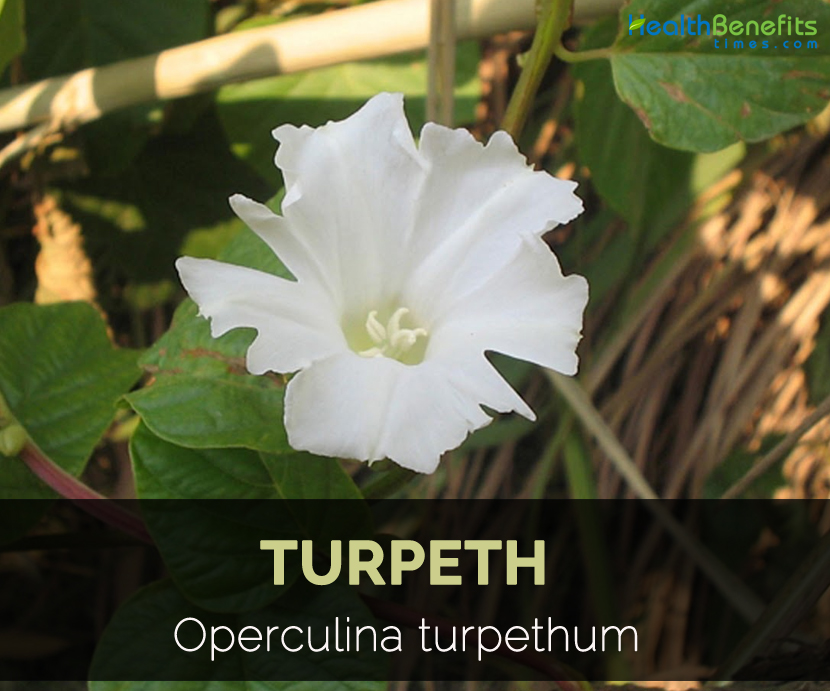| Turpeth Quick Facts | |
|---|---|
| Name: | Turpeth |
| Scientific Name: | Operculina turpethum |
| Origin | Asia; India, Nepal, Bangladesh, Pakistan, Sri Lanka, China, Taiwan and Myanmar |
| Shapes | Round, 1 to 1.5 centimeters |
Usually it is grown as a souvenir for Ayurvedic herbal remedies. The plant is a perennial aromatic creeper with triangular or rectangular stems. It owns lots of leaves in bunches. Leaves are oval in shape and measures 2 to 5 inches long. Roots are cylindrical in shape. It has 3 to 4 stems which holds white flowers and fruit. Stems are round and measures 1/2 or 3/4 inches in diameter. The flowering and fruiting occurs from March to December.
Roots are sweet, bitter, carminative, purgative, hepatic, acrid, expectorant, anti-pyretic and stimulant. It is used in various remedies as a cure for colic, intermittent fever, jaundice, dropsy, constipation, obesity, tumors and paralysis. Root bark incorporates glycosidic resin that has insoluble glycoside turpethein. Also it has large number of secondary metabolites which includes saponins, glycosides, flavonoids and phenolics. Moreover, various phytoconstituents such as glycosidic resin, beta-sitosterol, coumarin are contained in it.
Plant description
Turpeth is a large climber and perennial twinner with simple, triangular or rectangular stems. Stems are pubescent, twisting, winged and angled, usually tough and brown when become old. Roots are long, slender, much branched and fleshy. The thin root is circular having irregular wavy outline and measures 4 mm in diameter. Leaves are simple, pubescent on both sides but vary in shape. Leaves are oval about 2 to 5 inches long. The leaf base is cordate or truncate and about 5 -12.5 cm long and 1.3-7 cm wide. Flowers are white, campanulate with long sepals formed in cymes of few flowers which give way to globose capsules that are enclosed within overlapping brittle sepals. Capsules are round about 1-1.5 cm with four smooth seeds. Seeds are black, shiny and about 2 inches long.
- Soft stem is sucked or chewed.
- Unripe and fleshy fruits are consumed raw or cooked like peas.
Medicinal Uses
- In India, Turpeth is used to hasten bowel movements.
- In Ayurvedic system of medicine, root bark and seeds are used for treating skin disorders, constipation, fever, chronic gout, ulcers, bronchitis, tumors, hemorrhoids, jaundice, obesity, herpes and induced lacrimation.
- Use the root powder for flatulence, rheumatism, scorpion sting, paralysis and snake bites.
- Fresh leaves juice is used for conjunctivitis and corneal opacity.
- In Tanzania, decoction made with rhizome and leaves are used to eliminate hookworm.
- Use rhizome decoction to facilitate childbirth.
- In Mauritius, leaves decoction is used as a purgative.
- Take rhizome infusion internally for treating anorexia, fever, oedema, obesity, anemia, cough, hemorrhoids, dyspepsia, asthma, paralysis, flatulence, rheumatism, gout, abdominal tumors and menancholia.
- Apply the rhizome’s paste externally for snakebites, scorpion stings, worm infestation, ulcers, wounds, skin disorders, vitiligo and pruritus.
- For tuberculosis, herpes and vomiting of blood, use the mixture of rhizome powder, honey and butter.
- Apply the mixture of rhizome powder and fresh juice leaves as eye drops for treating corneal opacity and conjunctivitis.
- In western India, flowers are applied to head for treating headache.
- The herb is used in Chinese medicine to treat oedema and as an astringent.
- For rheumatic and paralytic affections, use this herb with ginger.
- It is used in folk medicine for treating constipation, rheumatism, jaundice, piles, chronic gout and tumors.
- Apply the roots to chancres, hemorrhoids and ulcerations.
- The oil extracted from root bark is used for dermatologic scaly diseases.
- In Nepal, root bark is used as antacid and laxative.
- It eases the passage of stool and promotes bowel movements.
- It relieves the symptoms related with hemorrhoids such as redness, irritation, itching, swelling around anus.
- It manages the symptoms such as swelling of tissues under skin, stretched skin and increase in abdomen size.
- It cleanses toxins.
Medicinal applications
- For dropsy, use 2 to 4 grams of tuberous roots blended with chebulic myroblan.
- For gout, use turpeth in equivalent manner such as dropsical infections.
- Take one or two tablespoons of turpeth with hot water twice every day to treat jaundice.
- Grind the stem of turpeth root and mix rock salt and long pepper. Take this powder (6 grams) for constipation.
- Grind equal quantity of aloe vera, turpeth, radish juice and white catechu. Let it remain for 24 hours. Make half gram tablets with this and dry in shadow. Take 1 to 2 tablets regularly twice a day for piles.
- Apply the paste of sesame, turpeth root, madder root, purgative croton, rock salt, honey and ghee on affected area. This cures fistula.
- Prepare a powder by grinding 50 grams turpeth root, 25 grams sugar and 10 grams pepper. Lick 14 spoons of this powder with honey to provide relief from indigestion.
- For jaundice, take the mixture of turpeth root powder and sugar (10 grams) twice a day daily.
Dosage
Powder: 1-3 grams (divided dose per day).
Precautions
- Not to be used in pregnancy, children below 12 years of age, elderly people, physically or mentally weak persons and in people with diarrhea, recta prolapse, bleeding per rectum and fecal incontinence.
- It acts as abortificient when used at the time of pregnancy.
- People might experience the side effects such as abdominal pain, vomiting, dehydration, chest pain, vertigo, hypotension, confusion, shock and unconsciousness with the use of Turpeth root.
References:
https://pdfs.semanticscholar.org/7d7f/647126ce6f19a7ed66f0e871fc1a849f3064.pdf
https://www.itis.gov/servlet/SingleRpt/SingleRpt?search_topic=TSN&search_value=504030#null
http://www.unanijournal.com/articles/76/3-1-6-213.pdf
http://e-charak.in/echarak/templates/Nardostachys%20%20grandiflora%20%20%20DC..pdf
https://en.wikipedia.org/wiki/Operculina_turpethum
https://indiabiodiversity.org/species/show/265807
https://www.planetayurveda.com/library/trivrit-operculina-turpethum/
http://www.stuartxchange.org/Bangbangau.html
https://www.tabletwise.com/medicine/turpeth-root
Comments
comments
